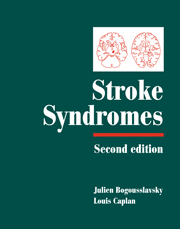Book contents
- Frontmatter
- Contents
- List of contributors
- Preface
- PART I CLINICAL MANIFESTATIONS
- PART II VASCULAR TOPOGRAPHIC SYNDROMES
- 29 Arterial territories of human brain
- 30 Superficial middle cerebral artery syndromes
- 31 Lenticulostriate arteries
- 32 Anterior cerebral artery
- 33 Anterior choroidal artery territory infarcts
- 34 Thalamic infarcts and hemorrhages
- 35 Caudate infarcts and hemorrhages
- 36 Posterior cerebral artery
- 37 Large and panhemispheric infarcts
- 38 Multiple, multilevel and bihemispheric infarcts
- 39 Midbrain infarcts
- 40 Pontine infarcts and hemorrhages
- 41 Medullary infarcts and hemorrhages
- 42 Cerebellar stroke syndromes
- 43 Extended infarcts in the posterior circulation (brainstem/cerebellum)
- 44 Border zone infarcts
- 45 Classical lacunar syndromes
- 46 Putaminal hemorrhages
- 47 Lobar hemorrhages
- 48 Intraventricular hemorrhages
- 49 Subarachnoid hemorrhage syndromes
- 50 Brain venous thrombosis syndromes
- 51 Carotid occlusion syndromes
- 52 Cervical artery dissection syndromes
- 53 Syndromes related to large artery thromboembolism within the vertebrobasilar system
- 54 Spinal stroke syndromes
- Index
- Plate section
38 - Multiple, multilevel and bihemispheric infarcts
from PART II - VASCULAR TOPOGRAPHIC SYNDROMES
Published online by Cambridge University Press: 17 May 2010
- Frontmatter
- Contents
- List of contributors
- Preface
- PART I CLINICAL MANIFESTATIONS
- PART II VASCULAR TOPOGRAPHIC SYNDROMES
- 29 Arterial territories of human brain
- 30 Superficial middle cerebral artery syndromes
- 31 Lenticulostriate arteries
- 32 Anterior cerebral artery
- 33 Anterior choroidal artery territory infarcts
- 34 Thalamic infarcts and hemorrhages
- 35 Caudate infarcts and hemorrhages
- 36 Posterior cerebral artery
- 37 Large and panhemispheric infarcts
- 38 Multiple, multilevel and bihemispheric infarcts
- 39 Midbrain infarcts
- 40 Pontine infarcts and hemorrhages
- 41 Medullary infarcts and hemorrhages
- 42 Cerebellar stroke syndromes
- 43 Extended infarcts in the posterior circulation (brainstem/cerebellum)
- 44 Border zone infarcts
- 45 Classical lacunar syndromes
- 46 Putaminal hemorrhages
- 47 Lobar hemorrhages
- 48 Intraventricular hemorrhages
- 49 Subarachnoid hemorrhage syndromes
- 50 Brain venous thrombosis syndromes
- 51 Carotid occlusion syndromes
- 52 Cervical artery dissection syndromes
- 53 Syndromes related to large artery thromboembolism within the vertebrobasilar system
- 54 Spinal stroke syndromes
- Index
- Plate section
Summary
Recent studies emphasize multiple cerebral infarcts as new clinical patterns. The underlying clinical, topographic, etiologic and functional characteristics are now well known. The term multiple brain infarcts has been used to designate a variety of different infarcts which appear in one or both hemispheres, or in supratentorial and infratentorial arterial territories (multilevel). Multiple brain infarcts are composed either of simultaneous multiple infarcts or of infarcts of different chronological age. We will review in the following sections the current literature on the frequency and causes of multiple brain infarcts, particular clinical and/or topographic patterns that suggest specific underlying mechanisms and causes.
Frequency and incidence of multiple cerebral infarcts
Previous studies using different methods (first strokes vs. all strokes, acute and old) give a variety of definitions related to multiple brain infarcts. Disagreement exists about the definition of the disorder. In the Lausanne Stroke Registry, among 2000 consecutive patients whose first strokes were confirmed by cranial computed tomography (CT) or magnetic-resonance imaging (MRI), 3% of the patients had infarcts in ‘multiple territories’ supplied by the carotid arteries, 2% had multiple infarcts in the vertebrobasilar artery territory, and 2% had multiple infarcts in the territories of the carotid and vertebrobasilar arteries (Bogousslavsky, 1991a). In our hospital-based Ege Stroke Registry, we found almost similar frequency of multiple infarcts; 2% of the multiple infarcts were in the carotid territory, 3% were in the vertebrobasilar artery territory, and 3% were in the territories of the carotid and vertebrobasilar arteries (Kumral et al., 1998).
- Type
- Chapter
- Information
- Stroke Syndromes , pp. 499 - 511Publisher: Cambridge University PressPrint publication year: 2001
- 2
- Cited by



